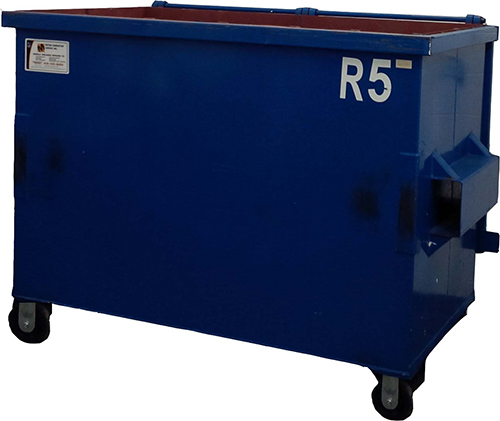Multi-Residential Recycling
Learn about multi-residential recycling requirements and responsibilities below.
Set-out requirements
- Recycling is collected every Thursday for front-end wheeled bins and every Friday for carts.
- Recycling material must be placed out for collection no later than 7 a.m. on collection day.
- Recyclable materials all mixed together in 96-gallon blue recycling carts or front-end wheeled bins (three to eight cubic yard capacity).
- Items must be placed at the designated collection area approved by the City.
Example of 96 gallon blue recycling cart
| Example of front-end wheeled bin
|
Recycling responsibilities for residents
- Ask the property manager how the building’s recycling program works.
- Store items in a blue box or reusable blue bag until full. When the blue box or bag is full, place loose items directly into the recycling container of the building or down the chute. Do not place items in plastic bags.
- Bring flattened cardboard to the recycling room instead of putting it down the chute; this helps prevent chutes from becoming blocked by cardboard.
- Corrugated Cardboard must be flattened to no larger than 0.6 metres by 0.6 metres by 0.3 metres (two feet by two feet by one foot).
Recycling responsibilities for property managers
- Recycling in multi-residential buildings is mandatory (Environmental Protection Act, O Reg. 103/94).
- Ensure all proper bins are purchased and maintained for the entire building. Due to space restrictions, a few small multi-residential buildings have been approved by the City to use the standard City-issued curbside blue boxes.
- Ensure recycling containers set out for collection are free of contamination and that all recycling bins have acceptable materials. A recycling container will be deemed 'contaminated' if the contents are mixed with garbage and/or non-collectible waste. Contaminated recycling containers will not be collected.
- Ensure that separate garbage bins are in or near the recycling room for residents to dispose of plastic bags and other non-recyclable material.
- Monitor recycling area(s) to ensure residents are following correct recycling procedures.
- Ensure recycling containers are not overflowing. This can be done by purchasing more blue boxes or rotating the boxes more frequently.
- Promote organics collection throughout the building. Hang posters showing what is acceptable and not acceptable (PDF) in the City’s organics program in the waste room as well as other areas frequented by residents.
- Read the City’s Waste Collection By-law 132-2017 (PDF) for a full list of requirements and owner’s responsibilities.
What goes in the recycling bin?

Plastic bottles and food containers (empty and rinsed)
- Antifreeze, windshield washer fluid and other vehicle care containers
- Household cleaning bottles including detergent, bleach and cleaner bottles under 15 litres
- Food tubs and lids including yogurt, ice cream and margarine containers
- Water bottles and beverage bottles
- Personal care product bottles including shampoo and dish soap bottles
Glass bottles and jars (empty and rinsed)
- Pasta sauce, pickle, baby food and jam jars
- Mason jars
- Beverage bottles (alcoholic beverage containers can be returned to The Beer Store)
Aluminum and steel (empty and rinsed)
- Aerosol cans and paint cans (empty and with lid removed)
- Aluminum foil, trays, and pie plates
- Pop cans and food and beverage cans and lids
- Metal lids
Cartons and boxes
- Cardboard (flatten and tie in bundles with string, no larger than 0.6 metres by 0.6 metres by 0.3 metres (two feet by two feet by one foot)
- Tetra Pak packages
- Milk and juice cartons and juice boxes (no straws)
- Boxboard including cereal boxes and shoe boxes
- Spiral-wound containers such as Pillsbury dough, frozen juice, or Pringles
- Toilet paper and paper towel rolls
- Egg cartons
- Household paper
- Office paper
- Books (remove hard covers)
- Brown paper bags
- Newspapers (remove plastic sleeve)
- Flyers, magazines and mail


